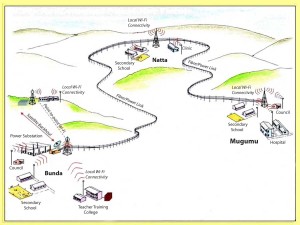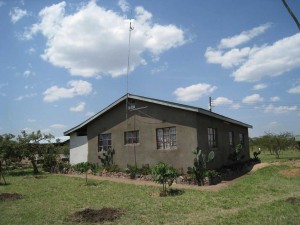In August last year I spent two weeks helping on a project delivering internet connectivity within the Bunda and Serengeti regions of Tanzania. The project, run by a Tanzanian group called ICT for Rural Development (ICT4RD), is identifying the most appropriate and sustainable technical solutions for use in delivering connectivity to rural Tanzania, so as to work out the best technical design as a model to roll out across the country.
The project is partnered with the Dar es Salaam Institute of Technology, The Tanzanian Commission for Science and Technology, and the Swedish International Development Agency.
The project initially links up schools, health centres, hospitals and council offices over 150 km into the Serengeti between Bunda, Natta and Mugumu, providing Internet connectivity and Voice over IP between these locations. The next phase of the project is to attract commercial customers, who are willing to pay for the connectivity thus making it economically sustainable.
The principle behind the technical design of the project is sharing a single satellite internet link between multiple users, therefore sharing the cost and making it more affordable. The cost of a satellite link is the most expensive operational cost in providing internet connectivity to remote areas. For example, Bunda Teaching Training College was paying around $400 a month for its satellite connection, but found this too expensive, and was going to have to shut it down or ask students to fund it out of their pockets. The ICT4RD solution now provides Internet connectivity to the college at a fraction of the cost.

Fig 1 – Internet connection layout for the project area
Figure 1 shows a layout of the project. The satellite link, and associated server equipment is housed in Bunda electricity substation. This is a good dual use of infrastructure, as the substation provides a secure and air-conditioned environment for the ICT equipment, as well as a reliable source of power. The Internet connection is transported 150 kms to Mugumu via Natta through the use of a fibre optic cable running above the electricity cables. Again this is a good dual use of infrastructure with the electricity poles being used for two purposes, and the copper shielded fibre acting as lightning protection for the electricity cables. The internet access is delivered from Wi-Fi (Wireless network con- nectivity) hubs located along the cable, to the schools, hospitals and council offices. Wi-Fi is a good choice as it is quick and easy to deploy, requires no cables to be run to the buildings, is readily available and low cost. Also, if focused in a point to point beam, it can transmit over long distances of several miles.

Fig 2 – Wi-Fi aerial at teacher’s office in Natta
Figure 2 shows the Wi-Fi aerial located in the teachers office at Natta Secondary School. As can be seen, it is a simple technology making it easy to install and maintain.
The potential benefits the internet can bring to these locations are already being seen in the schools connected. The Headmaster in Natta secondary school advised that the teachers are able to research lessons using up to date subject matter, or teach on subjects which before they could not as they had no suitable text books. They are also looking at remote learning possibilities for teachers, allowing them to continue their professional development without having to leave Natta. This could help alleviate the issue of teachers only staying short periods at remote schools due to returning to university. Bunda Teacher Training College has seen monthly evaluation exam results improve, and better quality material prepared for lessons. The number of scholarships and placements achieved by the trainee teachers has also gone up. Further work is required to help the other schools, and hospitals make use of the computers and internet, but once a few are using it productively, it should help spread the benefits. The advantage Tanzania has, along with other countries in a similar position, is that they can make a technology leap to the latest appropriate technology without making incumbent infrastructure redundant. Access to information and the ability to communicate is key to improving society, services and businesses.
